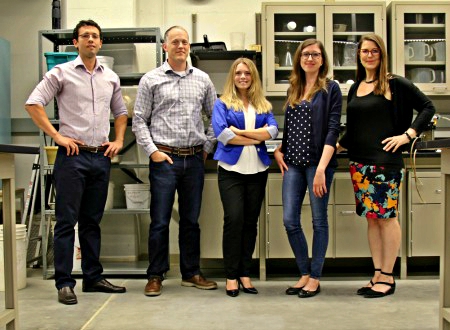
TEAM CREATIVITY: As as part of a creative sentencing order, UAlberta engineering scholars are researching ground hazards in the workplace. They are: (L-R) Renato Macciotta Pulisci, Michael Hendry, a master's student Kathleen Baker, a post-doctoral fellow Kristen Tappenden, and the team lead Lianne Lefsrud.
(Edmonton) In the early morning hours of January 19, 2014, a veteran employee of Suncor Energy died in a workplace accident. Jerry Cooper, a 40-year-old tailings operator who had worked for the company for 13 years, fell through the ground, softened by a leaking tailings pipeline, and was unable to free himself. He was one of nearly 900 Canadians whose lives are lost in the workplace every year.
But an innovative creative sentence under the Alberta Occupational Health and Safety (OHS) Act addresses the tragedy of Cooper's death by enhancing the protection of workers against ground hazards. In April 2017, through a negotiated agreement on all sides, a Provincial Court judge ordered Suncor to fund a project to help manage ground hazards that endanger personnel in their day-to-day operations.
"When you think about a tailings facility, what often comes to mind is the safety measures in place against a catastrophic failure. As far as ongoing operations and worker safety are concerned, there hasn't been much done," said Lianne Lefsrud, a professor in the Department of Chemical and Materials Engineering and the lead of the research team. "We have identified an important gap in the research, which we aim to fill."
"The penalty money will directly be addressing the root causes of the incident," said Renato Macciotta Pulisci, a Department of Civil and Environmental Engineering research associate and one of the research team members.
Suncor Energy is investing $285,000 in the David and Joan Lynch School of Engineering Safety and Risk Management to enhance risk management tools to guard against ground hazards posed to personnel on worksites across the province.
"We were heartbroken by Jerry's death and we want to make sure something like this never happens again to another oil sands employee across the industry," said Mark Little, Suncor's president of Upstream. "This investment to strengthen industry safety is an important way to honour Jerry's memory and make sure his passing was not in vain. This is the commitment we've made to Jerry's family."
"With this outcome we are not just addressing these specific concerns, but also building the capacity for similar issues in the wider industry," said Michael Hendry, a professor in the Department of Civil and Environmental Engineering and one of the research team members.
By the end of the project, oil sands facilities operators will have an extra layer of protection against potential geotechnical hazards added to the safety tools they already use.
"We will develop a methodology to enhance OHS hazard management tools at the field-level that address the potential for ground hazards," said Macciotta Pulisci.
The two-year study focuses on enhancing worker awareness and safety at tailings storage and fluid tailings transportation facilities such as ponds, dykes, dams, and pipelines.
Potential ground hazards around these facilities are difficult to detect for untrained personnel and pose an increased risk to anyone without a geotechnical background working in the area. Few people would even consider the possibility that the ground is unstable as ground conditions don't change very often or very fast.
"It [the study] shows how the David and Joan Lynch School of Engineering Safety and Risk Management is not focused on theoretical research and teaching; it's hands-on, we work with industry to offer solutions to real-world problems," said Macciotta Pulisci.
Approved by the court on April 24, the project's kick-off meeting is scheduled for July in Fort McMurray where the research team and students-Kristen Tappenden, a post-doctoral fellow, and Kathleen Baker, a master's student-will be interviewing tailings operators to identify their current health and safety practices for field operations, investigating potential ground hazards, and reviewing risk management regulations.
Although initiated and funded solely by Suncor Energy, other oil sands companies have expressed their interest in this project.
"The project is a learning process for the focal company, but then there's spillover learning to other related companies in other related industries," said Lefsrud.
Once the research team has reviewed the current safety measures and identified potential geotechnical hazards associated with tailings facilities and daily operations, it will develop 'red flags' heralding the onset of a ground hazard, and present safety recommendations to the participating companies that would enhance worker safety.
The first one of its kind, the project has the potential for making 'invisible' hazards more visible, creating additional safety measures with a layer of protection analysis (LOPA) approach, and enhancing worker safety in other fields-similar methodologies could apply to railroads, and even cyber security.
"There's going to be more work, whether or not this will involve working with oil sands tailings operators, or with mining companies in other regions, and even other industry partners whose workforce might be exposed to ground hazards," said Lefsrud.
"The David and Joan Lynch School of Engineering Safety and Risk Management will be hiring additional professors to do more research. This project demonstrates the value that the School brings to industry in enhancing worker safety, to government regulators in leveraging change with focal and related firms, and to students in understanding how risk management tools can be applied across different workplaces," said Lefsrud.